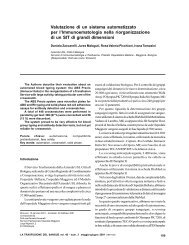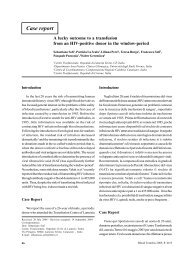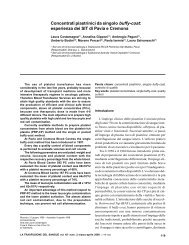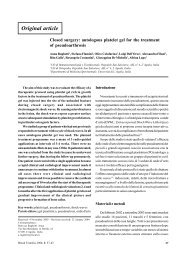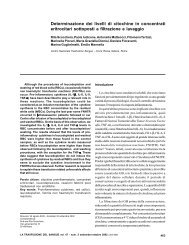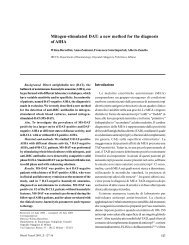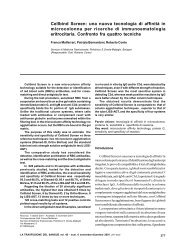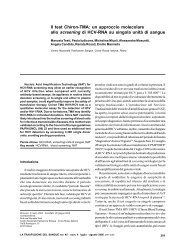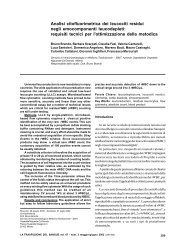Case report - Blood Transfusion
Case report - Blood Transfusion
Case report - Blood Transfusion
Create successful ePaper yourself
Turn your PDF publications into a flip-book with our unique Google optimized e-Paper software.
M Waldner et al.<br />
the aid of Ortho and Immucor normal and ficin-treated<br />
red cell panels (Gamma Biologicals Inc, Houston, TX,<br />
USA). The adsorption and elution procedures (Elu<br />
Kit II, Gamma Biologicals Inc), antibody titration,<br />
and reactivity enhancement were carried out according<br />
to the indications in the Technical Manual of the<br />
AABB 3 and the instructions provided by the<br />
companies producing the diagnostic materials.<br />
<strong>Case</strong> <strong>report</strong><br />
In March 1999, at the start of her first pregnancy,<br />
the 24-year old patient, FE, underwent blood group<br />
typing at our <strong>Transfusion</strong> Service. She was found to<br />
be group A, RhD negative, with a ccdee phenotype.<br />
Antibody screening carried out contemporaneously<br />
by an indirect antiglobulin test (IAT) was negative. A<br />
second test during the 20 th week of pregnancy<br />
confirmed the absence of irregular antibodies. In<br />
September (in the 36 th week of pregnancy), an anti-E<br />
antibody was identified; this antibody reacted only<br />
with undiluted serum.<br />
Since the woman's husband was group B, RhD<br />
positive, with a ccDEE phenotype, the patient was<br />
monitored frequently in order to intervene quickly,<br />
should the antibody titre increase significantly. In<br />
October, as the woman reached term, a second<br />
antibody with anti-D specificity at a titre of 1:4 was<br />
identified in the absence of passive<br />
immunoprophylaxis and, therefore, presumed to be<br />
due to early materno-foetal alloimmunisation. A few<br />
days later the woman delivered a neonate, FO, with<br />
group O RhD positive, ccDEe phenotype. The neonate<br />
had a negative direct antiglobulin test (DAT) and no<br />
clinical complications.<br />
Given the alloimmunisation, anti-D<br />
immunoprophylaxis was not administered, but the<br />
woman was advised to undergo an<br />
immunohaematological control six months later,<br />
which confirmed the presence of only the anti-D<br />
antibody at a titre of 1:2.<br />
From October 2001, in a series of frequent controls<br />
during her second pregnancy the patient showed,<br />
unlike during the first pregnancy, both anti-D and anti-<br />
E antibodies at low titres, which could only be detected<br />
with red cells pretreated with proteolytic enzymes;<br />
the anti-E antibody disappeared in the 35 th week,<br />
leaving just the anti-D antibody which reacted only<br />
with enzyme pretreatment, with a 2+ score.<br />
158<br />
(Elu Kit II, Gamma Biologicals Inc), di titolazioni<br />
anticorpali, di potenziamento delle reattività sono state<br />
condotte secondo le indicazioni del Technical Manual<br />
dell'AABB 3 e delle ditte produttrici dei materiali<br />
diagnostici.<br />
Descrizione del caso<br />
Nel marzo 1999, all'inizio della sua prima<br />
gravidanza, la paziente FE di 24 anni, effettuò presso<br />
il nostro Servizio Trasfusionale la determinazione del<br />
gruppo sanguigno (A Rh, D negativo, fenotipo ccdee)<br />
e lo screening anticorpale (effettuato con test indiretto<br />
all'antiglobulina, TIA), risultato negativo. Un secondo<br />
controllo alla ventesima settimana di gestazione<br />
confermò l'assenza di anticorpi irregolari; nel mese<br />
di settembre (alla 36 a settimana di gestazione) venne<br />
identificato un anticorpo con specificità anti-E,<br />
reattivo solo con siero indiluito.<br />
Essendo il coniuge di gruppo B Rh, D positivo,<br />
fenotipo ccDEE, si eseguirono controlli ravvicinati<br />
per intervenire tempestivamente nell'eventualità di un<br />
incremento significativo del titolo anticorpale. Nel<br />
successivo mese di ottobre, in prossimità del parto,<br />
fu evidenziato un secondo anticorpo con specificità<br />
anti-D, a titolo 1:4, in assenza di immunoprofilassi<br />
passiva e, quindi, presumibilmente imputabile a<br />
un'iniziale alloimmunizzazione materno-fetale.<br />
Pochi giorni dopo la donna partorì un neonato, FO,<br />
di gruppo O RhD positivo, fenotipo ccDEe, con test<br />
diretto all'antiglobulina (TDA) negativo e nessuna<br />
complicanza clinica.<br />
Vista l'alloimmunizzazione, non fu eseguita<br />
l'immunoprofilassi anti-D, ma venne consigliato un<br />
controllo immunoematologico a distanza di sei mesi,<br />
che confermò la presenza del solo anticorpo anti-D a<br />
titolo 1:2.<br />
Dall'ottobre 2001, durante il decorso della sua<br />
seconda gravidanza e diversamente dalla prima<br />
gestazione, la paziente FE presentò, in una serie di<br />
controlli ravvicinati, l'associazione degli anticorpi<br />
anti-D ed anti-E a basso titolo, rilevabili<br />
esclusivamente con emazie pretrattate con enzimi<br />
proteolitici; l'anticorpo anti-E scomparve alla 35 a<br />
settimana, permanendo il solo anticorpo anti-D<br />
reattivo in enzimi, con score 2+.<br />
Anche il secondo figlio di FE, di gruppo A Rh D<br />
positivo, fenotipo ccDEe, presentò alla nascita un<br />
TDA negativo e nessun sintomo di MEN.<br />
<strong>Blood</strong> Transfus 2005; 3: 157-60



